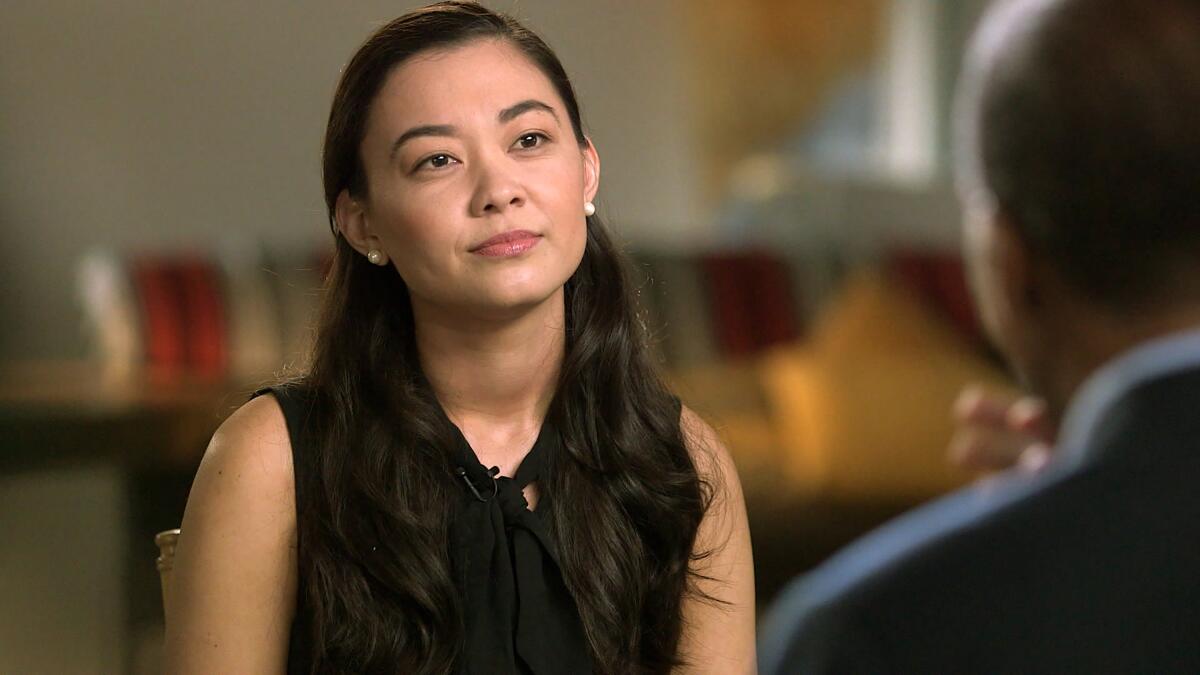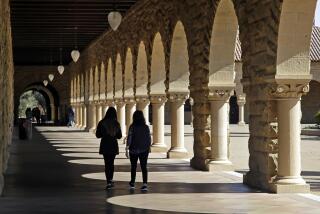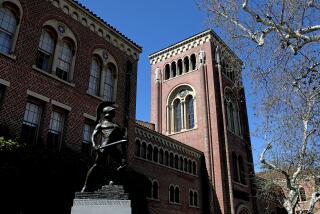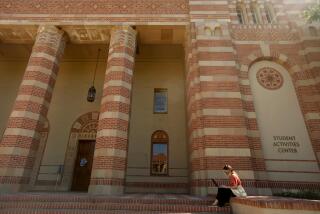A sexual assault, a new garden and the fight at Stanford over Chanel Miller’s voice

- Share via
In June 2016, a woman known only as Emily Doe read a 12-page single-spaced letter inside a courtroom to the man who had sexually assaulted her behind a dumpster on Stanford’s campus more than a year before.
Her statement was published online the following day and quickly emerged as a viral rallying cry for survivors of sexual violence. Now, three years later, her words are at the center of a clash between Stanford students and administrators.
Chanel Miller, who publicly identified herself in September as the 23-year-old who was attacked by Stanford student Brock Turner, came to an agreement with the university: The scene of the crime would be transformed into a garden and marked with a plaque etched with words of Miller’s choosing from her victim impact statement.
In the two years since the garden was built, the university has twice rejected the language Miller chose for the plaque, instead offering alternatives she has nixed.
Miller withdrew from the project, and the space — flanked by wooden benches and a bubbling fountain — has remained devoid of any context. The university has argued that her selected language could be triggering for victims of sexual violence.
And that has sparked a debate about whether her words — which have profoundly influenced how society talks about sexual assault — are too raw for a public space or simply offend the sensibilities of Stanford leaders.
The crime that occurred in that space ultimately changed the law. Turner was sentenced to six months in jail and served only three. The sentence spurred widespread outrage and prompted then-Gov. Jerry Brown to sign legislation that would ensure similar perpetrators would receive mandatory prison time. And Judge Aaron Persky — who handed Turner the light sentence in the case — was the first California judge to be recalled in 85 years.
Turner, who was 20 when he assaulted Miller, will remain on the sex offender’s list for the rest of his life. The former competitive swimmer left Stanford and was banned from swimming competitions. In addition to his jail sentence, Turner was given three years’ probation, which expires this year.
But on the Stanford campus, many say the impact from Miller’s assault is less visible.
Students recently launched a petition to install a permanent plaque selected by Miller, collecting nearly 1,700 signatures from students, faculty and alumni. But in its absence, a virtual marker went live last week with Miller’s chosen passage: “You took away my worth, my privacy, my energy, my time, my safety, my intimacy, my confidence, my own voice, until today.”
The disagreement over the plaque surfaced publicly in 2018. Stanford Provost Persis Drell released a statement labeling Miller’s word choice as a “trigger” for survivors of sexual assault.
“We consulted with sexual violence counselors and others who work with Stanford students who are survivors of sexual assault. They advised that rather than creating a healing environment for survivors, the quote could have a serious, negative impact for some survivors of sexual violence,” Drell wrote.
But according to Miller’s account in her newly released memoir, “Know My Name,” the initial rejection seemed largely influenced by the university’s belief that her choice of words targeted Turner, the former student who sexually assaulted Miller on campus when she was 23.
“One year after our meeting, a month after the garden installation, the plaque was still not there,” Miller said. “When my lawyer inquired about it, [the provost] wrote that the space was meant to be inspirational, and it was not OK to target or condemn a single individual.”
After the university rejected Miller’s second choice of wording for the plaque, offering alternatives she deemed inappropriate, Miller pulled out of the project. The garden has remained without any indicator of what happened there in the predawn hours of Jan. 18, 2015.
The recent petition to install a permanent plaque launched the same week that a student-led augmented reality project made its debut at the site, showing a virtual rendering of Miller’s marker when viewed through an iPad.
Students and faculty gathered in the space, a 20-minute walk from the central campus, on Sept. 27. More than 50 people wrote letters expressing hope for what the garden could mean to future students. The “Dear Visitor” letters, shared with The Times, spoke of personal traumas and criticized the university for refusing to let Miller’s voice be heard.
“To ignore one survivor is to ignore all of them,” one letter read.
“I read Chanel’s statement and I know we’ve been in the same place,” read another.
“Chanel’s story resonates on this campus. She is far from alone.”
“Words are powerful and Chanel best knows what she wants to say.”
In a statement, Stanford said it stands by its decision to censor the plaque wording but welcomed the initiative “that offers the use of augmented reality in the space and provides visitors the agency to engage with the garden and its purpose.”
“The university wanted to ensure the space would provide a supportive environment for all survivors, not all of whom may have reached the same point of post-traumatic healing, and who might have a range of emotional reactions,” the university said.
Hope Schroeder, a recent Stanford graduate who created the project with students Kyle Qian and Khoi Le, doesn’t think the current interactive solution is the best display for the space.
“We don’t see our project as a replacement for a physical plaque,” Schroeder said. “No one would know about the project without a physical demarcation.”
The three students initially had planned an augmented reality project on Confederate monuments 3,000 miles away from campus. But they changed course amid the outcry over the garden space. With Miller’s approval, the trio reimagined the area to preserve “the collective memory of students.”
Schroeder described the garden as an “eerily distant calm” in the middle of an area where students have played beer pong and held pig roastings. She was surprised that so many faculty trekked to the out-of-the-way area when the augmented reality project launched. Many who visited said they had passed the planted area before, unaware of its significance.
“It looks like the tragedy was papered over but not remembered,” Schroeder said of the garden.
That sentiment is echoed in Miller’s book and by campus leaders.
Shanta Katipamula was a freshman when Miller’s impact statement went viral. Now a graduate student, she helped launch the petition to make sure that new university students — who would have been entering high school at the time of Miller’s assault — know about the attack.
“There’s so few students who have witnessed this chronology of events from start to finish,” the former student body president said. “It’s really important to me that that wasn’t the case and that new students on campus were educated on the history.”
Emma Tsurkov, a PhD candidate and director of sexual violence prevention for the Associated Students of Stanford University, said the controversial garden plaque is part of the university’s larger need to strengthen its response to sexual assault complaints.
If nothing else, Tsurkov said, the back-and-forth over the plaque and the interest in Miller’s case have spurred an increase in conversations about and action around sexual violence. In the spring, the university agreed to a study examining how often sexual assault occurs on campus and where it’s mostly likely to happen. The results are expected this month.
Michele Landis Dauber, a professor and advocate of Miller’s who led the campaign to recall Persky urged Stanford to reform the garden space and referred to the nonexistent plaque as an erasure of any acknowledgment of what happened to Miller.
Dubious of the university’s “trigger” rationale for its rejection of Miller’s wording for the marker, she said that “There, There” — a book that details Native American genocide and includes a story about a woman who is raped — was one of three books that incoming freshmen were expected to read this year, without any warning.
“We mailed that to every freshman. There was no talk of a trigger warning,” she said.
Stanford professor David Palumbo-Liu is lobbying to get Miller’s memoir on the required reading list for next year’s incoming freshmen.
He’s received nearly 700 signatures in support of adding the book to the reading list, which a nominated faculty member oversees each year. Palumbo-Liu said the university has never shied away from offering students texts about violence, genocide and trauma and thinks the book could provide another avenue for acknowledgment of Miller’s attack. He said, however, that it should not be a substitute for the garden plaque.
“The main issue is to get the plaque and for Stanford to fulfill its promise,” Palumbo-Liu said. “Institutions should be held to the same ethical standards as individuals.”
For now, campus visitors can read her chosen words, if only virtually.
More to Read
Sign up for Essential California
The most important California stories and recommendations in your inbox every morning.
You may occasionally receive promotional content from the Los Angeles Times.











